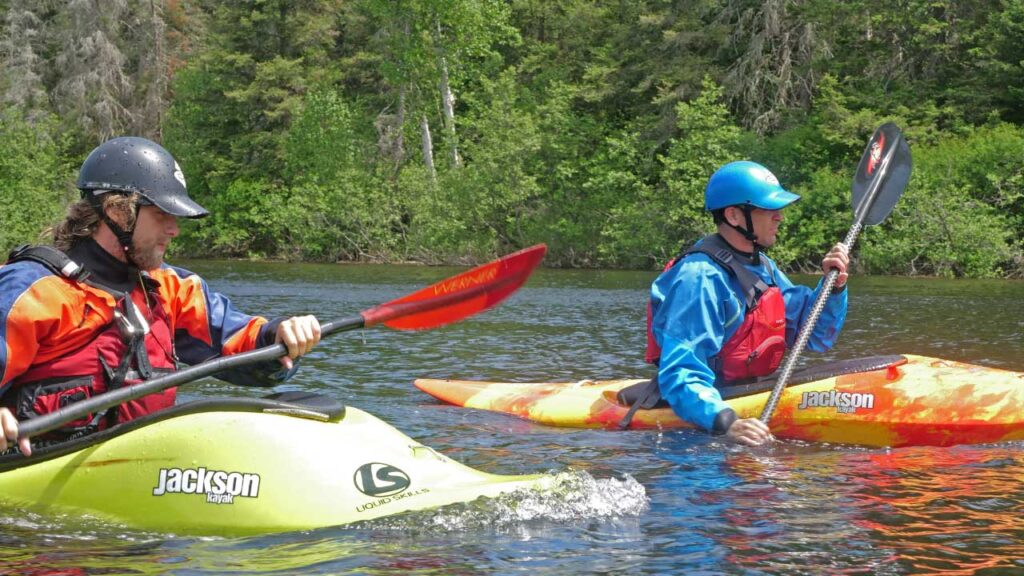When paddling in cold conditions, some kind of technical getup will be necessary to keep you safe and comfortable. But choosing between a wetsuit vs drysuit can be a bit confusing, and also subjective. I wanted to share my personal thoughts, to help you get an idea of what might work best for you.
Don't put that kayak into storage! There are ways to have fun on the water, even when it's chilly. Cold water kayaking means choosing between wetsuit vs drysuit.

Wetsuits keep you warm
Wetsuits are tightly-fitting body coverings made of neoprene. They are designed to keep you warm while paddling, surfing, swimming, or scuba diving in cooler conditions. When the suit gets wet, it holds a thin layer of water between it and your skin. Your body will then heat this fluid, which creates a warm cocoon.
Snug fitted wetsuits insulate better
The catch is that the suit has to be tight, otherwise that layer of liquid insulation won't stay in place. A loose fitted wetsuit will be constantly flushed with fresh, cold water. Purchasing a wetsuit that fits tightly means that as we grow (i.e. either a child who is maturing or an adult who is…umm…expanding), wetsuits will have to be replaced with bigger sizes that fit.
Wetsuits enhance flotation
The big advantage to wetsuits is that they enhance flotation. Extra flotation without impeding too much range of motion, if you can tolerate a thinner design. This is a major reason why they're so popular amongst surfers. Wetsuits are also less expensive and can be repaired easier than drysuits.
What are the different types of wetsuits?

Wetsuits come in a variety of sizes/options/thicknesses. The style with long legs and shoulder straps is typically called a “Farmer John.” If you're in cooler waters, then you may also want to wear a wetsuit top with a long-sleeves. Wetsuit tops sometimes are worn in conjunction with a simple bathing suit bottom. There's also the classic “Shorty” wetsuit, which essentially connects a neoprene t-shirt and shorts in one continuous piece.
Drysuit vs Wetsuit

I've been primarily using the same drysuit for over 15 years. And to be perfectly honest, I no longer own a wetsuit. I've gotten soft over the years. Even though I've enjoyed some wild paddling adventures in places like the Arctic, and the Grand Canyon during Christmas, I've still developed a strong preference for staying dry.
Budget boater vs Comfort boater
When I was younger, I only used wetsuits. Wetsuits work perfectly fine as long as they're sized properly. The the main downside is that they have to be wet in order to keep you warm. I don't want to be wet anymore so I prefer the drysuit.
Maintenance of the drysuit is key
If your drysuit is in good condition (click here to learn about drysuit maintenance) then you should be able to step out of it after a solid paddling session without having a drop of water on your clothes. And if you opt for the built in foot covers (rather than ankle gaskets), then you can wear a pair of cozy socks, and keep your toes just as dry as the rest of your body.
Drysuits are easier to get into and out of vs wetsuits
Another advantage that drysuits have over wetsuits is that they're much easier to get in and out of. This means less of a struggle on the bookends of an otherwise fun paddling day, and also much less of a panic when Mother Nature calls (which tends to happen more often when it's cold out). Oh, and while we're on the subject, spend the extra dough and get a drysuit with a “relief zipper.” You won't regret it.
Maintenance of the zippers on a drysuit
A minor drawback to drysuits is that the heavy-duty zippers do need to be maintained and lubed up in order to function properly over time.
Drysuits cost more than wetsuits
The one major con of drysuits is how expensive they are. A good drysuit (and I do recommend you commit to something high-quality if you go down this road) will push you north of $1,000 (USD). However, if you treat it well, you'll get years and years and years of extended paddling seasons, and exciting cold-weather expeditions out of your purchase.

Does a drysuit keep you warm?
On its own, a drysuit is designed to not only keep you dry (no surprise there) but also to have some insulating properties. But the real comfort comes from the layers you choose to wear underneath. Since a drysuit fits so much looser than a wetsuit, a full range of cold-weather apparel can be worn (or not worn) underneath. It all depends on the conditions, and how hot your personal furnace burns.
I hope that helps you make sense of this important paddler's crossroads. If you're still a young-pup, or more stoic than I am, then a wetsuit might be the way to go. But if you're like me, and just want to stay dry at all costs, then maybe the drysuit will be your preference too. Either way I hope this article helped you answer wetsuit vs drysuit.

Dry Suits: NRS Axiom, Level Six Emperor
Kayaks: Jackson Kayak Rockstar, Jackson Kayak Antix
Paddles: Aqua Bound
In that case, you may want to check out my review of the NRS Axiom and Level Six Emperor drysuits. And as always, head on over to PaddleTV for a steady stream of fun and informative paddling content.








